 W
WThis is a list of kingdoms in pre-colonial Africa.
 W
WThe Adamawa Emirate is a traditional state located in Fombina, an area which now roughly corresponds to areas of Adamawa State and Taraba state in Nigeria, and previously also in the three northern provinces of Cameroon, including minor Parts of Chad and the Central African Republic. It was founded by Modibo Adama, a commander of Sheikh Usman dan Fodio, the man who began the Fulani jihad in 1809. The capital was moved several times until it settled in Yola, Nigeria on the banks of the Benue River in Nigeria around 1841. At the time of Adama's death his realm encompassed parts of modern Nigeria and much of north Cameroon. It was technically part of the Sokoto Caliphate, and it had to pay a tribute to the leaders in Sokoto.
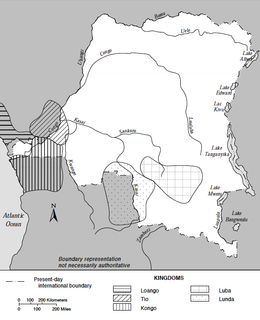 W
WThe Anziku Kingdom, also called the Teke Kingdom, the Tyo Kingdom or Tio Kingdom, was a pre-colonial West Central African state of modern Republic of Congo, Gabon and Democratic Republic of Congo.
 W
WThe Aro Confederacy (1690–1902) was a political union orchestrated by the Aro people, Igbo subgroup, centered in Arochukwu in present-day southeastern Nigeria. Their influence and presence was all over Eastern Nigeria, lower Middle Belt, and parts of present-day Cameroon and Equatorial Guinea during the 18th and 19th centuries. The Arochukwu Kingdom was an economic, political, and an oracular center as it was home of the Ibini Ukpabi oracle, High Priests, the Aro King Eze Aro, and central council (Okpankpo).
 W
WThe Asante Empire was an Akan empire and kingdom from 1701 to 1957, in what is now modern-day Ghana. It expanded from Ashanti to include the Brong-Ahafo Region, Central Region, Eastern Region and Western Region of present-day Ghana as well as some parts of Ivory Coast and Togo. Due to the empire's military prowess, wealth, architecture, sophisticated hierarchy and culture, the Ashanti Empire has been extensively studied and has more books written by European, primarily British authors than any other indigenous culture of Sub-Saharan Africa.
 W
WThe Sultanate or Kingdom of Bagirmi or Baghermi was a kingdom and Islamic sultanate southeast of Lake Chad in central Africa. It was founded in either 1480 or 1522 and lasted until 1897, when it became a French protectorate. Its capital was Massenya, north of the Chari River and close to the border to modern Cameroon. The kings wore the title Mbang.
 W
WThe Battle of Gawakuke was an engagement fought between the Sokoto Caliphate and the Gobir city-state at Gawakuke in northern Nigeria on 9 March 1836. The battle was a victory for Sokoto, and secured the Gobir kingdom's subordination to the caliphate.
 W
WBiffeche or Bifeche is an area of Senegal centred on the town of Savoigne, around 30 kilometres north-east of the major coastal city of Saint-Louis.
 W
WThe Kanem–Bornu Empire existed in areas which are now part of Chad and Nigeria. It was known to the Arabian geographers as the Kanem Empire from the 8th century AD onward and lasted as the independent kingdom of Bornu until 1900. The Kanem Empire was located in the present countries of Chad, Nigeria and Libya. At its height it encompassed an area covering not only most of Chad, but also parts of southern Libya (Fezzan) and eastern Niger, northeastern Nigeria and northern Cameroon. The Bornu Empire (1380s–1893) was a state in what is now northeastern Nigeria, in time becoming even larger than Kanem, incorporating areas that are today parts of Chad, Niger, Sudan, and Cameroon. The early history of the Empire is mainly known from the Royal Chronicle or Girgam discovered in 1851 by the German traveller Heinrich Barth.
 W
WCayor was the largest and most powerful kingdom (1549–1879) that split off from the Jolof Empire in what is now Senegal. Cayor was located in northern and central Senegal, southeast of Walo, west of the kingdom of Jolof, and north of Baol and the Kingdom of Sine.
 W
WThe Kingdom of Dahomey was an African kingdom that existed from about 1600 until 1904, when the last king, Béhanzin, was defeated by the French, and the country was annexed into the French colonial empire. Dahomey developed on the Abomey Plateau amongst the Fon people in the early 17th century and became a regional power in the 18th century by conquering key cities on the Atlantic coast.
 W
WThe Sultanate of Damagaram was a Muslim pre-colonial state in what is now southeastern Niger, centered on the city of Zinder.
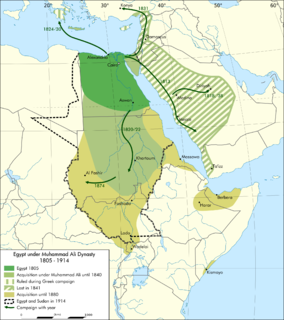 W
WThe Turco-Egyptian conquest of Sudan was a major military and technical feat. Fewer than 10,000 men set off from Egypt, but, with some local assistance, they were able to penetrate 1,500 km up the Nile River to the frontiers of Ethiopia, giving the Ottoman's an empire as large as Western Europe.
 W
WThe Ethiopian Empire, also formerly known by the exonym Abyssinia, or just simply known as Ethiopia, was a monarchy that spanned a geographical area in the current states of Ethiopia and Eritrea. It began with the establishment of the Solomonic dynasty by Yekuno Amlak from approximately 1270 and lasted until 1974, when Emperor Haile Selassie was overthrown in a coup d'état by the communist Derg. It was throughout much of its existence surrounded by hostile forces in the African Horn however it managed to preserve and develop its ancient form of Christianity based kingdom.
 W
WThe Fula jihads were a series of jihadist wars that occurred across West Africa during the 18th and 19th centuries led largely by the Muslim Fula people. The jihads and the jihad states came to an end with European colonization.
 W
WThe Funj Sultanate, also known as Funjistan, Sultanate of Sennar or Blue Sultanate due to the traditional Sudanese convention of referring to black people as blue was a monarchy in what is now Sudan, northwestern Eritrea and western Ethiopia. Founded in 1504 by the Funj people, it quickly converted to Islam, although this embrace was only nominal. Until a more orthodox Islam took hold in the 17th century, the state remained an "African-Nubian empire with a Muslim facade". It reached its peak in the late 17th century but declined and eventually fell apart in the 18th. In 1821 the last sultan, greatly reduced in power, surrendered to the Ottoman Egyptian invasion without a fight.
 W
WThe Imamate of Futa Jallon or Jalon was a West African theocratic state based in the Fouta Djallon highlands of modern Guinea. The state was founded around 1727 by a Fulani jihad and became part of the French Third Republic's colonial empire in 1896.
 W
WThe Imamate of Futa Toro (1776-1861) was a West African theocratic state of the Fula-speaking people centered on the middle valley of the Senegal River. The region is known as Futa Toro.
 W
WThe Empire of Great Fulo, also known as the Denanke Kingdom or Denianke Kingdom, was a pre-Islamic Pulaar kingdom of Senegal, which dominated the Futa Tooro region. Its population dominated its neighbors through use of cavalry and fought wars against the Mali and Songhai empires.
 W
WThe Jolof Empire, also known as the Wolof or Wollof Empire, was a West African state that ruled parts of Senegal from 1350 to 1549. Following the 1549 battle of Danki, its vassal states were fully or de facto independent; in this period it is known as the Jolof Kingdom.
 W
WThe Kaabu Empire (1537–1867), also written Gabu, Ngabou, and N'Gabu, was a great empire in the Senegambia region centered within modern northeastern Guinea-Bissau, larger parts of today's Gambia; extending into Koussanar, Koumpentoum, regions of Southeastern Senegal, and Casamance in Senegal. The Kaabu Empire consisted of several languages namely: Balanta, Jola-Fonyi, Mandinka, Mandjak, Mankanya, Noon (Serer-Noon), Pulaar, Serer, Soninke, and Wolof. It rose to prominence in the region thanks to its origins as a former imperial military province of the Mali Empire. After the decline of the Mali Empire, Kaabu became an independent Empire. Kansala, the imperial capital of Kaabu Empire, was annexed by Futa Jallon during the 19th century Fula jihads. However, Kaabu's vast independent kingdoms across Senegambia continued to thrive even after the fall of Kansala; this lasted until total incorporation of the remaining Kingdoms into the British Gambia, Portuguese and French spheres of influence during the Scramble for Africa.
 W
WKaarta, or Ka'arta, was a short-lived Bambara kingdom in what is today the western half of Mali.
 W
WKakongo was a former small kingdom located on the Atlantic coast of Central Africa, in the modern-day Republic of Congo and Cabinda, Angola. It along with its southern neighbor, Ngoyo, and Loango, its neighbor on the north were important political commercial centers during the seventeenth through nineteenth centuries. The people speak a dialect of the Kikongo language and thus may be considered a part of the Bakongo ethnicity.
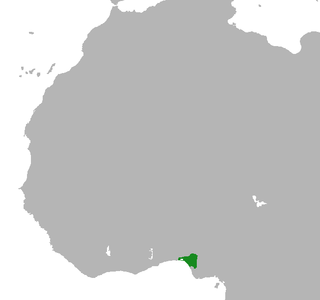 W
WThe Kingdom of Benin, was a kingdom in West Africa in what is now southern Nigeria. It is not to be confused with Benin, the modern-day nation-state. The Kingdom of Benin's capital was Edo, now known as Benin City in Edo state. The Benin Kingdom was "one of the oldest and most highly developed states in the coastal hinterland of West Africa". It was formed around the 11th century AD", and lasted until it was annexed by the British Empire in 1897.
 W
WThe Kingdom of Dahomey was an African kingdom that existed from about 1600 until 1904, when the last king, Béhanzin, was defeated by the French, and the country was annexed into the French colonial empire. Dahomey developed on the Abomey Plateau amongst the Fon people in the early 17th century and became a regional power in the 18th century by conquering key cities on the Atlantic coast.
 W
WThe Kingdom of Matamba (1631–1744) was a pre-colonial African state located in what is now the Baixa de Cassange region of Malanje Province of modern-day Angola. It was a powerful kingdom that long resisted Portuguese colonisation attempts and was only integrated into Angola in the late nineteenth century.
 W
WThe Kingdom of Kongo was a kingdom located in central Africa in present-day northern Angola, the western portion of the Democratic Republic of the Congo, the Republic of the Congo as well as the southernmost part of Gabon. At its greatest extent it reached from the Atlantic Ocean in the west to the Kwango River in the east, and from the Congo River in the north to the Kwanza River in the south. The kingdom consisted of several core provinces ruled by the Manikongo, the Portuguese version of the Kongo title Mwene Kongo, meaning "lord or ruler of the Kongo kingdom", but its sphere of influence extended to neighbouring kingdoms, such as Ngoyo, Kakongo, Loango, Ndongo and Matamba, the latter two located in what is Angola today.
 W
WKororofa was a multiethnic state and/or confederacy centered along the Benue River valley in what is today central Nigeria. It was southwest of the Bornu Empire and south of the Hausa States. They rose to prominence before 1500, were in conflict with their more powerful neighbours in the 17th century, and reduced to a small tribute state by the 18th century. It is believed that Kwararafa was either a confederacy conquest state, led by the modern Jukun people or perhaps a collective name given by their Muslim foes for a number of pagan peoples to their south.
 W
WThe Kingdom of Loango was a pre-colonial African state, during approximately the 16th to 19th centuries in what is now the western part of the Republic of the Congo, Southern Gabon and Cabinda. Situated to the north of the more powerful Kingdom of Kongo, at its height in the 17th century Loango influence extended from Cape St Catherine in the north to almost the mouth of the Congo River.
 W
WThe Nation of Lunda was a confederation of states in what is now the Democratic Republic of Congo, north-eastern Angola, and north-western Zambia, its central state was in Katanga.
 W
WThe Massina Empire was an early nineteenth-century Fulbe Jihad state centered in the Inner Niger Delta area of what is now the Mopti and Ségou Regions of Mali. Its capital was at Hamdullahi.
 W
WThe Merina Kingdom or Kingdom of Madagascar, officially the Kingdom of Imerina, was a pre-colonial state off the coast of Southeast Africa that, by the 19th century, dominated most of what is now Madagascar. It spread outward from Imerina, the Central Highlands region primarily inhabited by the Merina ethnic group with a spiritual capital at Ambohimanga and a political capital 24 kilometres (15 mi) west at Antananarivo, currently the seat of government for the modern state of Madagascar. The Merina kings and queens who ruled over greater Madagascar in the 19th century were the descendants of a long line of hereditary Merina royalty originating with Andriamanelo, who is traditionally credited with founding Imerina in 1540.
 W
WThe Mossi are a Gur ethnic group native to modern Burkina Faso, primarily the Volta River basin. The Mossi are the largest ethnic group in Burkina Faso, constituting more than 40% of the population, or about 6.2 million people. The other 60% of Burkina Faso's population is composed of more than 60 ethnic groups, mainly the Gurunsi, Senufo, Lobi, Bobo and Fulani. The Mossi speak the Mòoré language.
 W
WThe Kingdom of Ndongo, formerly known as Angola or Dongo, was an early-modern African state located in what is now Angola.
 W
WThe Kingdom of Nri was a medieval polity located in what is now Nigeria. The kingdom existed as a sphere of religious and political influence over a third of Igboland, and was administered by a priest-king called an Eze Nri. The Eze Nri managed trade and diplomacy on behalf of the Nri people, a subgroup of the Igbo-speaking people, and possessed divine authority in religious matters.
 W
WThe prehistoric and ancient history of the Serer people of modern-day Senegambia has been extensively studied and documented over the years. Much of it comes from archaeological discoveries and Serer tradition rooted in the Serer religion.
 W
WThe Shilluk Kingdom was located along the banks of the White Nile river in modern South Sudan. Its capital and royal residence was in the town of Fashoda. According to their folk history and neighboring accounts, the kingdom was founded during the mid-fifteenth century CE by its first ruler, the demigod Nyikang. During the nineteenth century, the Shilluk were affected by military assaults from the Ottoman Empire and later British colonization in Anglo-Egyptian Sudan. The Shilluk king is currently not an independent political leader, but a traditional chieftain within the governments of South Sudan and Sudan. The current Shilluk king is His Majesty Reth Kwongo Dak Padiet who ascended to the throne in 1993.
 W
WThe Sokoto Caliphate was a sovereign Sunni Muslim caliphate in West Africa that was founded during the jihad of the Fulani War in 1804 by Usman dan Fodio. It was dissolved when the British conquered the area in 1903 and annexed it into the newly established Northern Nigeria Protectorate.
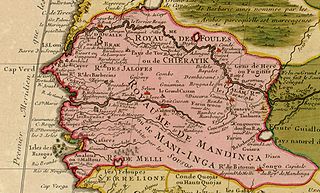 W
WWalo was a kingdom on the lower Senegal River in West Africa, in what are now Senegal and Mauritania. It included parts of the valley proper and areas north and south, extending to the Atlantic Ocean. To the north were Moorish emirates; to the south was the kingdom of Cayor; to the east was Jolof.
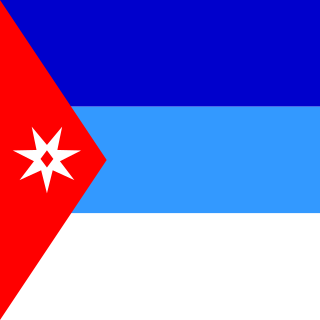 W
WThe Wassoulou Empire, sometimes referred to as the Mandinka Empire, was a short-lived (1878–1898) empire of West Africa built from the conquests of Malinke ruler Samori Ture and destroyed by the French colonial army.
 W
WThe Yeke Kingdom of the Garanganze people in Katanga, DR Congo, was short-lived, existing from about 1856 to 1891 under one king, Msiri, but it became for a while the most powerful state in south-central Africa, controlling a territory of about half a million square kilometres. The Yeke Kingdom also controlled the only trade route across the continent from east to west, since the Kalahari Desert and Lozi Kingdom in the south and the Congo rainforest in the north blocked alternative routes. It achieved this control through natural resources and force of arms—Msiri traded Katanga's copper principally, but also slaves and ivory, for gunpowder and firearms—and by alliances through marriage. The most important alliances were with Portuguese–Angolans in the Benguela area, with Tippu Tip in the north and with Nyamwezi and Swahili traders in the east, and indirectly with the Sultan of Zanzibar who controlled the east coast traders.